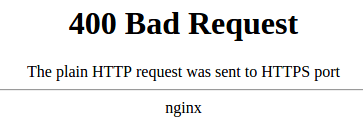Posts
- Rust errors explained simply
- I don't trust Gemini, but ...
- Hibernating to disk
- Django and manual data prefetch
- Django, window functions and paginator
- How I discovered MPV
- Pake - wrapping websites
- Accordion with animated height
- Nginx: HTTP and HTTPS on a single port
- NeoMutt: new Thunderbird
- How I solved the dilemma of personal notes
- Django model constraints
- Simple keyboard udev rule
- Kitchen LEDs and Home Assistant
- Home Assistant Nginx proxy server
- Rust and it's ability to insert/replace string into another string onto specific position
- Python HTML table parser without dependencies
- Python defaultdict with data
Nginx: HTTP and HTTPS on a single port
Let's say you have a website www.site.com. That site sits on a server that you connect to with a client - your browser. The browser communicates with the client on a protocol, in this case it's HTTP. But in nowadays internet communication in plain HTTP (which is not secured at all) is abandoned. Everyone use HTTPS which is HTTP with SSL layer so the communication is encrypted.
Each protocol uses a different port - HTTP uses port 80,
HTTPS port 443. Since HTTP is abandoned on production use
(but it's good enough for local development where you don't
need encryption) here comes the case where you want any request
that comes over HTTP to your site redirect to HTTPS. This is
just a simple redirect with a separated server directive
Now you have 2 access points (HTTP on port 80 + HTTPS on port 443) where one is just an alias to another. This also means that your server has to be open to listen on those 2 ports which is quite a standard.
Now imagine you have a testing server where you stack up your sites. Each site is complex and comes with it's own proxy (like Docker application with bundled Nginx). In such case you cannot put all those proxies from all those sites on the same ports 80 or 443. The solution is to reserve a set of ports for each site and bind them to docker proxy to port 80 and 443. So app1 will sit on port 2000 and 2001 which is gonna be binded to 80 or 443 respectively. App2 will sit on ports 2002 and 2003. This means your docker compose for each of the sites will looks like:
services: # ... nginx: # ... ports: - 2000:80 - 2001:443
Now each site blocks 2 ports on your server and you use pretty much the same code (see above in first code example) in each proxy config. If you drop the extra config from proxy, remove port binding for port 80 and try to access your site on http://site.com:2001 you get the "The plain HTTP request was sent to HTTPS port" error:

This error means that your client send an unecrypted HTTP request which landed on proxy that expects encrypted HTTPS request. Basically you mix those two protocols together.
So the question here is how to handle both HTTP and HTTPS on
a single port? Is that even possible? Well it's not possible to mix
up the communication but you can simulate the original idea with
HTTP -> HTTPS redirect in a nifty way. Luckily Nginx has a smart
solution and that's custom error code 497 which can be handled with
[error_code](http://nginx.org/en/docs/http/ngx_http_core_module.html#error_page)
directive. If we add a redirect with a proper code and an
URL we end up with the same effect that handles our original (
lately duplicate) configuration:
This code catches 497 and 301 codes and replaces them with
307
code and URL where client is redirected to. Note the variables that
are used and also the hard-coded port number. You cannot use
$server_port here, because that will be 443 since the
incoming request comes from 2001 port (on the machine) to 443
port (on the proxy).